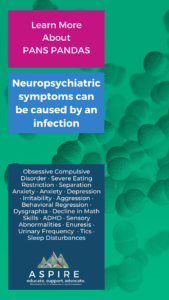What does Rare Disease Day mean for PANS/PANDAS?
In the PANS world, we say that PANS/PANDAS is not rare; it is just rarely diagnosed.
 One of the problems of perpetuating the idea that PANS is rare is that providers are not even considering an evaluation for PANS/PANDAS as they have been told it is very rare, so the likelihood of their patient’s symptoms being a result of PANS is too minimal for them to bother to learn about it which delays access to appropriate treatment and needless suffering. The message the medical community gives by saying this is that people with rare or rarely diagnosed disorders don’t matter enough to pay attention to. They do. You do. We do. OUR PANS COMMUNITY MATTERS.
One of the problems of perpetuating the idea that PANS is rare is that providers are not even considering an evaluation for PANS/PANDAS as they have been told it is very rare, so the likelihood of their patient’s symptoms being a result of PANS is too minimal for them to bother to learn about it which delays access to appropriate treatment and needless suffering. The message the medical community gives by saying this is that people with rare or rarely diagnosed disorders don’t matter enough to pay attention to. They do. You do. We do. OUR PANS COMMUNITY MATTERS.
So, yes, we do talk about Rare Disease Day. The outside medical community treats us as rare. Our research is underfunded, as rare diseases are. We are underdiagnosed, as rare diseases are. We are under-screened, as rare diseases are. Our families are extremely financially burdened, as most rare diseases are. We are misunderstood, as most rare diseases are. We are treated incorrectly or sub-optimally, as most rare diseases are.
This is why we aspire to close the gap between the onset of symptoms and the start of appropriate treatment and support. PANS patients and families can’t afford (financially, emotionally, or physically) diagnostic and treatment delays.
We know that chronic childhood conditions impact 54% of children; what percentage of those kids have PANS/PANDAS? What percentage of all our kids are being dismissed and misdiagnosed and therefore given incorrect treatment? Too many, not a rare amount.
More about the numbers.
Neither the prevalence nor the natural progression of PANDAS or PANS has been thoroughly documented. 1 in 200 was a number put together several years ago by PANDAS Network. It was based on numbers of other childhood disorders. NORD has taken PANS/PANDAS off their list of rare diseases, while GARD still lists PANDAS. Some studies look retrospectively at select patient populations, of which some only look at symptom onset near the time of a strep infection, which doesn’t consider other triggers, infectious and non-infectious, and that not all children have signs of acute strep throat as PANDAS is their immune response. One recent study reviewed case files of children who received primary care in three healthcare systems and estimated the “incidence of PANDAS/PANS was 1/11,765 for children between 3 and 12 years”, indicating “that PANDAS/PANS is a rare disorder with substantial heterogeneity across geography and time.” (PMID: 37808558). The “Benros study,” an epidemiological study in Denmark, showed the connection between frequent infections and a higher risk of mental disorders, including OCD, anxiety, restricted eating, and more, in young individuals. doi:10.1001/jamapsychiatry.2018.3428